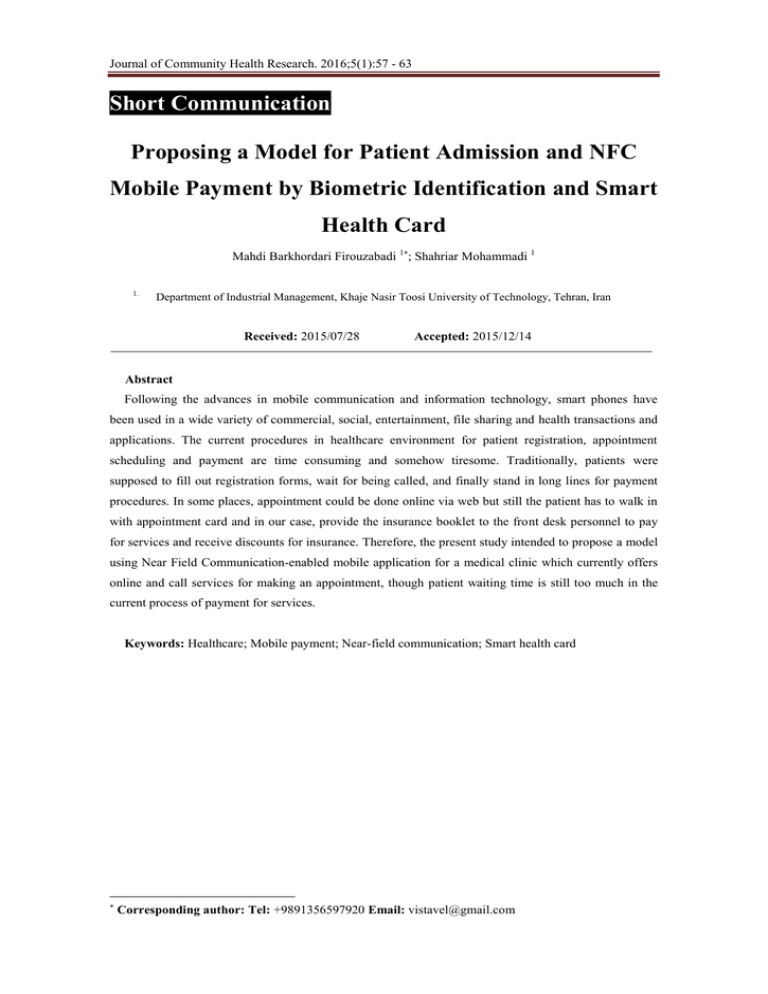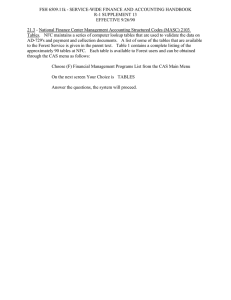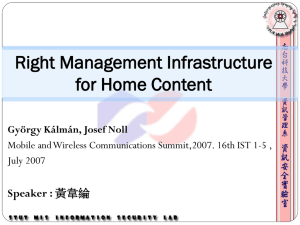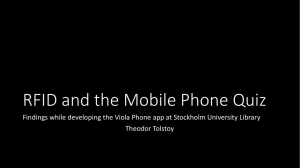Proposing a Model for Patient Admission and NFC Mobile Payment
advertisement

Journal of Community Health Research. 2016;5(1):57 - 63 Short Communication Proposing a Model for Patient Admission and NFC Mobile Payment by Biometric Identification and Smart Health Card Mahdi Barkhordari Firouzabadi 1; Shahriar Mohammadi 1 1. Department of Industrial Management, Khaje Nasir Toosi University of Technology, Tehran, Iran Received: 2015/07/28 Accepted: 2015/12/14 Abstract Following the advances in mobile communication and information technology, smart phones have been used in a wide variety of commercial, social, entertainment, file sharing and health transactions and applications. The current procedures in healthcare environment for patient registration, appointment scheduling and payment are time consuming and somehow tiresome. Traditionally, patients were supposed to fill out registration forms, wait for being called, and finally stand in long lines for payment procedures. In some places, appointment could be done online via web but still the patient has to walk in with appointment card and in our case, provide the insurance booklet to the front desk personnel to pay for services and receive discounts for insurance. Therefore, the present study intended to propose a model using Near Field Communication-enabled mobile application for a medical clinic which currently offers online and call services for making an appointment, though patient waiting time is still too much in the current process of payment for services. Keywords: Healthcare; Mobile payment; Near-field communication; Smart health card Corresponding author: Tel: +9891356597920 Email: vistavel@gmail.com 57 Mahdi Barkhordari Firouzabadi; Shahriar Mohammadi Introduction Managing patients' health records, beforehand, that the patient has to register appointment and medical service payments online, get informed of available dates and are inevitably effective and crucial to schedules and then after visiting the hospital, maintain the overall level of health standards hand in the insurance information, and wait for in a country. However, to reach a certain subsequent responses from the hospital staff. degree of satisfaction as well as efficiency The mean waiting time for walk-in patients in and effectiveness, management systems a hospital studied by Jabbari and colleagues is should be implemented with a certain degree approximately 48.72±42.53 min from the time of quality, which leads to the overall the patient enters to the hospital till admission satisfaction of patients and the medical and visiting the doctor [2]. On the other hand, a system, including patient waiting time and great deal of patients' files and records of their management of staffs, such as patient health registration, appointment, appointment records, laboratory and radiology handling patient's medical prescriptions and results, doctor visits and other related patient scheduling payment of health services [1] . Therefore, history, doctor prescriptions, records need to be handled. Recently inefficient flow of information and paper Information appointment systems eventually leads to Technologies (ICT) have become a widely delays in management of report updates as anticipated approach in healthcare sectors, to well as lengthy stays and lines of patients in ensure the quality and standards of medical the medical centers. The current procedures services followed in healthcare centers mostly fall procedures in which the patient is admitted for into one of the following categories [1]: being visited and checked up in the hospital is Appointments that the patients walk very essential for an automatic system with an in and are required to fill out a registration appropriate work flow in hospitals which form or present their identification card and provide an efficient healthcare environment insurance booklet to the registration staff and enable quick access to accurate medical and wait to be called upon. data [10]. These data were previously stored in a and Communication [3-25] . Identifying patients and the appointment paper-based manner which were low in cost beforehand, that the patient has to call in, but had limitations such as difficult access, ask for available dates or be informed time consuming updates and no major security Scheduling an [9] . These problems can be easily solved by the through an Interactive Voice Response (IVR) system and then walk in to the introduction of intelligent storage and retrieval medical center, and again wait in long lines mechanisms in healthcare sectors, namely for getting admitted to doctors. smart health cards. Smart cards can play a key role in sharing patient's specific information. Schedule and online appointment 58 Proposing a Model for Patient Admission and NFC Mobile… Smart cards tend to be cheap, easy to use and application including healthcare updated, which are normally not easily review damaged [9] . Today, regarding of various [17] literatures . A brief on ICT the applications in healthcare including general advancement of technologies such as Radio Benefits and advantages of using technologies, Frequency Identifier (RFID) and Near Field in particular NFC technology can be divided Communication (NFC), these technologies into four main categories shown in Fig 1 have been applied in various areas of (right). Figure 1: Typical RFID system parts (Left) & benefits and advantages of using NFC technology (right) Radio Frequency Identification (RFID) e.g. NFC based mobile payment which itself and Near Field Communication (NFC) is a good reason for conducting a research in RFID is a technology using radio waves, this field to enhance patient flow in such which was developed as an identification medical clinics considering criteria such as technology. It has gone through many the appointment request time and patient changes, entering new fields of application waiting time including Case Review and Problem Statement monitoring management systems and [17] information . This applied Fig 2 describes the general delays from the technology is comparable to the bar code time the patient requests an appointment to system, where a bar code (tags in RFID) is the time the patient actually visits the doctor. scanned using a barcode reader, whereas in Accordingly, the patient normally makes a RFID systems, the tags not only can be read reservation using the two options mentioned but also can be rewritten and they can read above. Once the appointment has been several tags simultaneously. Typical parts of scheduled, patients must report their arrival a RFID system have also been demonstrated to the clinic using a kiosk as mentioned in Fig 1 (left). On the other hand, NFC is an above and then wait possibly due to being enhanced RFID system which is already early until being called, since the reservation integrated into many smart devices including made using the Online or IVR system does current mobile phones [12]. not announce the exact time of visit to the Designing an efficient patient appointment patient. Finally the patient gets to be visited system can reduce the patient waiting time, by the doctor possibly waiting long minutes 59 Mahdi Barkhordari Firouzabadi; Shahriar Mohammadi before getting visited. Hence, the current majority of clinics and health care centers process for patients' admission in the has been illustrated in Fig 2. Figure 2: General delays in patient admission Results and Discussion In general, the procedures of getting admitted for the visit in this clinic can be categorized into four main sections: insurance and identity check, appointment reservation, prescriptions and doctor visit, and medical services payment. After introducing the proposed model for using NFC, biometric and smart health card technology in this clinic, and the enhanced system flow in Figure 4 can be demonstrated. The number of steps and processes eliminated from the system flow can be observed comparing the flow of patients in Figure 4 with Figure 5 which has significantly decreased. Therefore, by implementing the proposed system in a test clinical environment, not only the process flow of the system will be enhanced, but also a better clinical and medical environment will be provided for patients following the reduction in the total waiting time of patients. 60 Proposing a Model for Patient Admission and NFC Mobile… Figure 2: Current patient flow Conclusion Considering the advances in ICT, the proposed model for mobile payment, and medical services can be regarded influential in appointment and scheduling systems to reduce patient waiting time as well as increase efficiency of systems. The proposed model can be used as a basis for further research in this field. Figure 5: Patient flow after applying proposed model References 1. Symey Y, Sankaranarayanan S, binti Sait SN. Application of Smart Technologies for Mobile Patient Appointment System. International Journal of Advanced Trends in Computer Science and Engineering. 2013; 2(4):74-85. 2. Jabbari A, Jafarian M, Khorasani E, et al. Emergency Department Waiting Time at Alzahra Hospital. Director General. 2011;8(4):500-511[Persian]. 3. Rehman S, Coughlan J. An Efficient Mobile Payment System Based On NFC Technology. International Journal of Computer, Electrical, Automation, Control and Information Engineering. 2013;7(6):811-815. 4. Krishna AVG, Sreevardhan C, Karun S, et al. NFC-based Hospital Real-time Patient Management System. International Journal of Engineering Trends and Technology (IJETT), 2013;4(4):626-629. 61 Mahdi Barkhordari Firouzabadi; Shahriar Mohammadi 5. Joo-Hee P, Jin-An S, Young-Hwan O. Design and implementation of an effective mobile healthcare system using mobile and RFID technology, HEALTHCOM 2005 Proceedings of 7th International Workshop on Enterprise networking and Computing in Healthcare Industry, 2005; 263-266, doi: 10.1109/HEALTH.2005.1500454. 6. Bhat S, Sidnal NS, Maleshetty RS, et al. Intelligent Scheduling in Health Care Domain. International Journal of Computer Science Issues (IJCSI), 2011; 8(5): 214-224. 7. Wani SMA, Sankaranarayanan S. Intelligent Mobile Hospital Appointment Scheduling and Medicine Collection. International Journal of Computer and Communication System Engineering (IJCCSE), 2014; 1(2): 47-58. 8. Tyrone, E. and Suresh, S., Applications of Intelligent Agents in Hospital Search and Appointment System. International Journal of E-Services and Mobile Applications (IJESMA), 2011; 3(4): 57-81. 9. Latha NA, Murthy BR, Sunitha U. Smart Card Based Integrated Electronic Health Record System For Clinical Practice. International Journal of Advanced Computer Science & Applications, 2012; 3(10): 120-127. 10. Padhy RP, Patra MR, Satapathy SC. Design and implementation of a cloud based rural healthcare information system model, Universal Journal of Applied Computer Sciences and Technology, 2012, 2(1): 149-157. 11. Das R, NFC-enabled phones and contactless smart cards 2008–2018. Card Technology Today, 2008; 20(7–8): 11-13. 12. Puma J P, et al. Mobile Identification: NFC in the Healthcare Sector, Andean Region International Conference (ANDESCON), 2012 VI, 39-42, doi: 10.1109/Andescon.2012.19. 13. Mey YS, Sankaranarayanan S. Near Field Communication based Patient Appointment, CUBE '13 Proceedings of the 2013 International Conference on Cloud & Ubiquitous Computing & Emerging Technologies, 2013; 98-103, doi: 10.1109/CUBE.2013.27. 14. Alabdulhafith M, , Sampalli S. NFC-based Framework for Checking the Five Rights of Medication Administration. Procedia Computer Science, 2014; 37: 434-438. 15. Brabcová I, Bartlova S, Tothova V, et al. The possibility of patient involvement in prevention of medication error. Kontakt, 2014; 16(2): e65-e70. 16. Prinz A, Menschner P, Leimeister JM. Electronic data capture in healthcare—NFC as easy way for self-reported health status information. Health Policy and Technology, 2012, 1(3): 137-144. 17. Lahtela A, Hassinen M, Jylha V. RFID and NFC in healthcare: Safety of hospitals medication care, Pervasive Computing Technologies for Healthcare, 2008; 241-244, doi: 10.1109/PCTHEALTH.2008.4571079. 18. Pourghomi P, Ghinea G. Managing NFC payment applications through cloud computing, Internet Technology And Secured Transactions, 2012; 772-777. 19. Rodrigues H, Jose R, Coelho A, et al. MobiPag: Integrated Mobile Payment, Ticketing and Couponing Solution Based on NFC, Sensors, 2014; 14(8): 13389-13415. 20. Au YA, Kauffman R J. The economics of mobile payments: Understanding stakeholder issues for an emerging fin ancial technology application. Electronic Commerce Research and Applications, 2008; 7(2): 141-164. 21. Ma X, Wei W. The Architecture of Mobile Wallet System Based on NFC (Near Field 62 Proposing a Model for Patient Admission and NFC Mobile… Communication), Research Journal of Applied Sciences, 2014; 7(12): 2589-2595. 22. Chen W-D, Mayes KE, Lien YH, et al. NFC mobile payment with Citizen Digital Certificate, The 2nd International Conference on Next Generation Information Technology (ICNIT), 2011; 120-126. 23. ChenW, Hancke GP, Mayes KE. NFC mobile transactions and authentication based on GSM network, 2010 Second International Workshop on Near Field Communication (NFC), 2010;83-89, doi: 10.1109/NFC.2010.15. 24. Noh S-K, Lee S-R, Choi D. Proposed M-Payment System Using Near-Field Communication and Based on WSN-Enabled Location-Based Services for M-Commerce. International Journal of Distributed Sensor Networks, 2014;1-8, doi: http://dx.doi.org/10.1155/2014/865172. 25. Ondrus J, Pigneur Y. An assessment of NFC for future mobile payment systems, ICMB 2007 International Conference on the Management of Mobile Business, 2007;1-45, doi: 10.1109/ICMB.2007.9. 63




